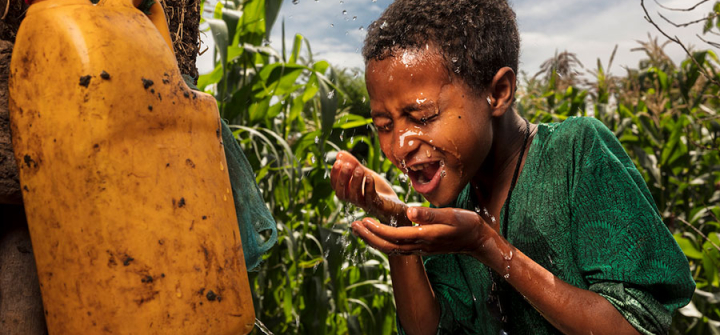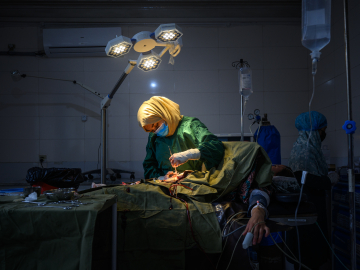Dramatic Reduction in Blindness is Good News—Let’s Finish the Job
In a world of gloomy global health news, progress against the leading cause of contagious and irreversible blindness—trachoma—is heartening. The WHO has reported a remarkable 91% reduction in people at risk of contracting the neglected tropical disease since 2002.
Trachoma is pink eye’s horrifying cousin. Most of us remember having pink eye (conjunctivitis)—a highly contagious eye infection—as a kid. But, with diligent eye and face washing, we easily recovered in a week or less, no worse for the wear. But trachoma, left untreated, causes small lesions under eyelids that force eyelashes to invert. Eventually, every blink painfully scratches the cornea. People blink more than 28,000 times per day—causing so much damage over the course of years that vision loss and blindness are irreversible.
Where trachoma is endemic, up to 90% of preschool-aged children are active cases. That’s why community health programs are doing outreach at schools like the Tema 1 Primary School in Malawi, teaching hand washing and hygiene to avoid flies (a major source of trachoma transmission). The lesson is reinforced in parent-teacher meetings. That’s critical because women, as primary caregivers, are twice as likely as men to develop late stage trachoma, called trichiasis, and 4 times more likely to go blind.
The battle against trachoma is being waged on 4 fronts, with the WHO and partners—in collaboration with health ministries and other government agencies—significantly scaling-up their “SAFE Strategy,” consisting of:
- Surgery to treat trichiasis;
- Antibiotics to treat early infection;
- Facial cleanliness; and
- Environmental improvements to prevent infection.
Last year, 95.2 million people were treated with antibiotics and 90,000+ surgeries took place—and more women received surgery for trichiasis.
The number of people at risk of trachoma has also decreased dramatically. The WHO estimates 137 million people remain at-risk—down from 1.5 billion people—with a 74% reduction in people requiring trichiasis surgery (from 7.6 million to 2 million). Ten more countries report trachoma is no longer a public health threat.
These are important advances. As you can imagine, the cost of trachoma—which renders 1.9 million people visually impaired or irreversibly blind—on lives and livelihoods is profound. It proliferates in the poorest, most rural areas of 44 countries in Africa, Central and South America, Asia, Australia and the Middle East—resulting in estimated productivity losses between $2.9–5.3 billion annually ($8 billion when late-stage trichiasis is considered).
These results are gratifying—but there’s a catch. There’s no guarantee these improvements will hold. The only lasting solution to prevent infection and reinfection, including in countries where trachoma is no longer considered endemic, is sustainable access to clean Water, Sanitation and Hygiene education (WASH). Not only is hand and face washing with clean water critical to keep flies out of people’s eyes, controlling the fly population requires proper waste management.
Yet roughly 40% of the world’s population does not have water service at home; 2 billion people do not have basic toilets or latrines; 44% of schools lack hand washing facilities (affecting well over 800 million children); and 37% lack basic sanitation. Even going to a health care facility can be dangerous when 45% of health care facilities in low-resource settings do not have water, soap, or hand sanitizer at points of care.
As we’ve seen in the fight against COVID-19, access to proper hand washing is key. Sustainably preventing trachoma—as well as many other costly, debilitating and deadly illnesses and diseases, like leprosy and schistosomiasis—requires WASH. In fact, all 20 NTDs can be better addressed with access to improved WASH across the continuum of prevention, treatment, care and disability management.
This year is critical for NTDs with the anticipated passage of an NTD Resolution at the November virtual World Health Assembly, to be followed by a draft 2021-2030 NTD Roadmap calling for the reduction of NTDs through greater cross-sector collaboration, country ownership, disease integration, and health systems strengthening—which requires WASH.
Now is the time to integrate the lessons learned by the students at the Tema 1 Primary School with increased investment and new partnerships at all levels to scale up the “F&E” in “SAFE.”
David A. Ross, ScD, is CEO and President of The Task Force for Global Health, which works in more than 150 countries to eliminate diseases and protect populations through programs in NTDs, vaccine equity, and health systems strengthening.
For the latest, most reliable COVID-19 insights from some of the world’s most respected global health experts, see Global Health NOW’s COVID-19 Expert Reality Check.
Join the tens of thousands of subscribers who rely on Global Health NOW summaries and exclusive articles for the latest public health news. Sign up for our free weekday enewsletter, and please share the link with friends and colleagues: https://www.globalhealthnow.org/subscribe
Fantanesh Gedefe, in Ethiopia’s Amhara Region, washes her face. Facial cleanliness is an integral component of the SAFE strategy for trachoma elimination. Image: Brent Stirton/Getty/Courtesy of the International Trachoma Initiative




